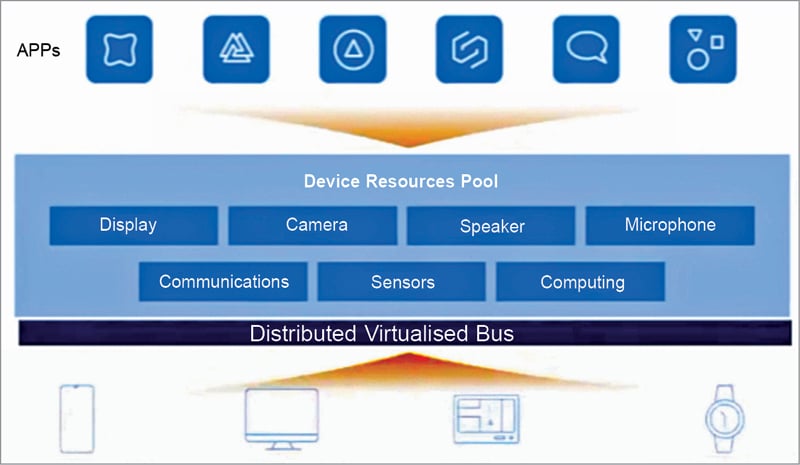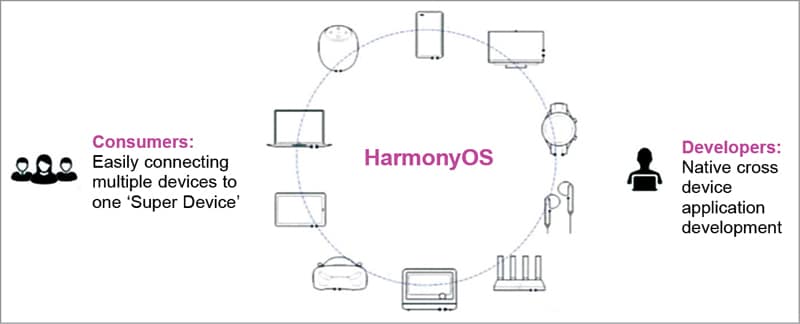Every smart device today runs on some form an operating system (OS) but often some of the devices being used run on different OS. This makes it hard to integrate them and make the devices communicate with each other to accomplish a particular task. HarmonyOS brings this nuisance to an end while supplementing the overall user experience. Read on for further information on the subject.
HarmonyOS is an operating system (OS) for all the smart devices that are out there. The tagline for HarmonyOS reads, “One as all, all as one.” It suggests that it is an OS capable of seamlessly running on multiple devices such that a single device can be used to access multiple devices, while making them function like a single device at the same time.
Let us first understand why it was needed in the first place. Some of these needs are:
- IoT (internet of things) devices have seen substantial growth over the past few years along with the saturation of smartphone devices. This is one of many prospects that brings about the need for an OS that collaborates harmoniously with smartphone devices.
- Operating systems are simply fragmented. There are different operating systems available that have been made by different vendors for various forms of devices, such as mobile phones, tablets, and smart watches. That makes it difficult to form a collaboration across each of them.
- It gets hard for application developers to develop an application for different platforms that use different operating systems. They have to learn about such platforms along with different sets of artifacts and operating systems.
What does HarmonyOS do?
HarmonyOS creates a resource pool (as shown in Fig. 1) across all the devices and using the distributed virtual bus it tries to connect them all. It helps application developers to combine the devices into a single super device. It allows the developed applications to use the resources from all the devices that are available, which is very useful for the end customer.

It is denoted as 1+8+N strategy (refer Fig. 2) by Huawei where ‘1’ focuses on devices such as smartphones, ‘8’ covers the majority of the devices such as eyewear, tablet, PC (personal computer), watch, speakers, vehicle terminal, earphones, TVs (television), and ‘N’ represents all the available IoT devices. It is backed and developed by Huawei. HarmonyOS currently supports 1+8 devices, which are backed and developed by Huawei itself.

HarmonyOS user scenarios
Based on the Harmony architecture you do not have to install any other application on your mobile in order to operate other devices. That is automatically done by the atomic service. It will initially complete the Wi-Fi provisioning and then you can start using it.
Fitness and health
You can use your mobile phone for cross-device resource convergence. There are devices like fitness bands, phones, weight trackers, and treadmills that can be collaborated into one super device with a simple integration of virtualisation that uses HarmonyOS as its backbone.
Smart home
Home appliances can easily be operated just with a touch of a button. You can preheat your oven and choose the right configurations to prepare a particular dish. You can receive notifications on your device that tell you when you should be changing the filter of your air-purifier. It even allows you to seamlessly receive customer care services and lets you get an appointment for the same.
It is important to note that these applications do not come pre-installed. Depending on the services you need and the type of device you have, the corresponding UI (user interface) is provided. The experience remains the same across all the devices.
Entertainment
For entertainment, users can stream the desired content onto bigger screens, they can use smart speakers and integrate a microphone, which allows them to have a collaborative experience. Again, all of this is controlled by a single device by the end user. They get to control all the components as per their need.
Smart office
Nowadays, most people are working from their homes. It is often difficult for people to move from one corner to another with their laptops when they have to. HarmonyOS gives them the flexibility to integrate all of their devices, such as TVs, phones, laptops, and tablets. This integration allows them to work from any device, and they can access all the files from any device and update them as well from anywhere they want. It improves convenience and increases productivity.
Easy travel
Sometimes while navigating your way to a certain destination you do not reach your exact destination while you are in your car. You might have to take a walk further to reach the exact destination. HarmonyOS grants you the ease to directly continue your navigation via your smartphone or a smartwatch (refer Fig. 3).

Development of HarmonyOS
HarmonyOS’s IDE (integrated development environment) of choice is DevEco Studio, which is based on IntelliJ platform. This IDE automatically adapts to multiple screen layouts and also provides previews. You can connect it to multiple hardware and perform live debugging as well. It even lets you use emulators based on different devices.
This IDE helps in creating a unified environment for multiple devices. There are multiple-language codes that help in developing in Java, JS (JavaScript), etc. You can develop a native application in C++ where atomic services can be built. Quick development of feature abilities and particle abilities can be done. In the terminology of HarmonyOS, feature abilities are the UI (user interface) based applications and particle abilities are service or data based applications that do not have a UI.
Advantages for application developers
Higher efficiency
Developers do not need to worry about the hardware specifications in order to create an application as it is hardware-independent. Multiple languages’ support is available for them to work on, such as Java, JS, C++, or C. They can write minimal code lines yet create feature-rich applications.
Developers can save time and money by relying on some reusable components that have already been built. This makes the development process faster.
Better consistency
The primary function will be consistent, allowing greater control and scalability for developers and a more consistent experience for the users.
Field-proven code
It consists of code that has been used many times and is already proven in the field. Hence, the likelihood of encountering problems during development lessens significantly.
Easy testing
Since the code is pre-tested, further testing becomes easier. Now, the testing is done to make sure any new features or sections work well.
On the whole, HarmonyOS has a strong collection of capabilities that can considerably improve the experience of users who want to create their own private ecosystem across several devices. It can be downloaded for free from GitHub. The users should always assess their requirements and select the best operating system for them.
This article, based on a tech talk session at OSI 2021 by Sharath K.S., Lead Architect, Huawei Technologies, has been transcribed and curated by Laveesh Kocher, a tech enthusiast at EFY who has a knack for open source exploration and research.








